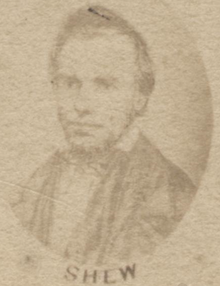Type a search term to find related articles by LIMS subject matter experts gathered from the most trusted and dynamic collaboration tools in the laboratory informatics industry.
Joel Shew | |
|---|---|
 | |
| Born | November 13, 1816 |
| Died | October 6, 1855 |
| Occupation(s) | Hydrotherapist, writer |
Joel Shew (November 13, 1816 – October 6, 1855)[1] was an American physician, hydrotherapist, and natural hygiene advocate.
Shew was born in Providence, Saratoga County. He initially worked in a daguerreotype shop in Philadelphia before obtaining his medical degree in 1843.[2] Shew developed an interest in hydrotherapy and traveled to Gräfenberg to study Vincenz Priessnitz's techniques.[3][4] His wife, Marie Louise Shew, was also a hydrotherapist. They were friends with Mary Gove Nichols, who had temporarily lodged at their home. The Shews operated a hydrotherapy "water-cure" house and welcomed patients.[2]
In 1844, Shew established the first water-cure institution in New York City.[3] In May 1845, he opened the New Lebanon Springs Water-Cure Establishment, an institution costing approximately US$3,000.[5] He served as the co-owner and advising physician, while David Campbell managed the institution for ten years.[5] Shew was influenced by Sylvester Graham's dietary principles and promoted natural hygiene practices, including regular bathing, exercise, massage, and abstention from alcohol and tobacco.[3] Historian Stephen Nissenbaum noted that "it is clear that Shew was a Grahamite before he discovered the water-cure".[6] Both Shew and his wife were vegetarians.[7]
In 1850, Shew contributed notes and additions to the American edition of William Lambe's Water and Vegetable Diet.[8] He died in Oyster Bay, Long Island.[1] An autopsy revealed that he had an enlarged liver and internal lesions, possibly due to chemical exposure from his earlier career as a photographer.[9]
In 1845, Shew launched The Water-Cure Journal, which gained significant popularity and, by 1850, had a subscription list of 50,000.[3] Russell Trall took over as editor in 1849, and the journal was later renamed The Herald of Health.[10][11][12]